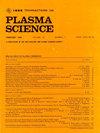用于筛选寄生信号的滤波器技术
IF 1.3
4区 物理与天体物理
Q3 PHYSICS, FLUIDS & PLASMAS
引用次数: 0
摘要
滤波器诊断使用带通滤波器和光电倍增管(PMT)来检测特定的光谱发射线。在射频等离子体相互作用实验(RF PIE)中,使用滤波器测量 W I 400.88 nm 线发射与离子能量的函数关系,以评估等离子体元件(PFC)上的 W 侵蚀情况。为了有效筛选出附近的杂质线,如 Ar II 401.39 nm 线,我们正在探索和比较不同的过滤技术。通过与光谱分辨率为 0.012 nm 的高分辨率 1.0 m Czerny-Turner 光谱仪的测量结果进行比较,可以确定这些技术的有效性。在对聚变装置(包括分流器和天线防护限制器)中的全氟化碳进行成像时,滤除附近杂质辐射的能力非常有用。氦等离子体的初步结果显示,在较高的偏置电压下,两种技术的差别不大。在直流偏置电压较低的氦等离子体中,使用两个不同波长的滤波器的双滤波技术在屏蔽背景信号方面更为有效。然而,在氩等离子体中收集的数据显示,在较低直流偏置电压下,在感兴趣的线上重叠滤光片的技术更接近光谱仪的数据。本文章由计算机程序翻译,如有差异,请以英文原文为准。
Filterscope Techniques for Parasitic Signal Screening
The filterscope diagnostic uses bandpass filters and photomultiplier tubes (PMTs) to detect specific spectral emission lines. A filterscope was used to measure the W I 400.88 nm line emission as a function of ion energy on the Radio Frequency Plasma Interaction Experiment (RF PIE) for the purpose of assessing W erosion on plasma-facing components (PFCs). Different filter techniques are being explored and compared in order to effectively screen out nearby impurity lines, like the Ar II 401.39 nm line. The effectiveness of these techniques is determined by comparing the measurements to a high-resolution 1.0 m Czerny-Turner spectrometer with 0.012 nm spectral resolution. The ability to filter out nearby impurity emissions is useful when imaging PFCs in fusion devices including divertor and antenna guard limiters. Initial results with a helium plasma show little difference between the two techniques at higher bias voltages. In a helium plasma at lower dc bias voltages, a two-filter technique with filters at two separate wavelengths was shown to be more effective at screening out background signals. Data collected with an argon plasma however show the technique with overlapping filters on the line of interest is a closer match to spectrometer data at lower dc bias voltages.
求助全文
通过发布文献求助,成功后即可免费获取论文全文。
去求助
来源期刊

IEEE Transactions on Plasma Science
物理-物理:流体与等离子体
CiteScore
3.00
自引率
20.00%
发文量
538
审稿时长
3.8 months
期刊介绍:
The scope covers all aspects of the theory and application of plasma science. It includes the following areas: magnetohydrodynamics; thermionics and plasma diodes; basic plasma phenomena; gaseous electronics; microwave/plasma interaction; electron, ion, and plasma sources; space plasmas; intense electron and ion beams; laser-plasma interactions; plasma diagnostics; plasma chemistry and processing; solid-state plasmas; plasma heating; plasma for controlled fusion research; high energy density plasmas; industrial/commercial applications of plasma physics; plasma waves and instabilities; and high power microwave and submillimeter wave generation.
 求助内容:
求助内容: 应助结果提醒方式:
应助结果提醒方式:


